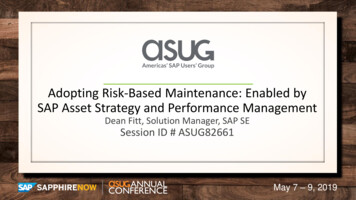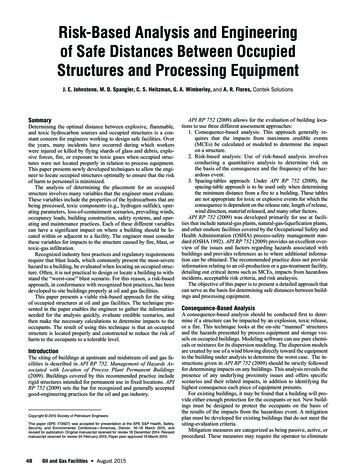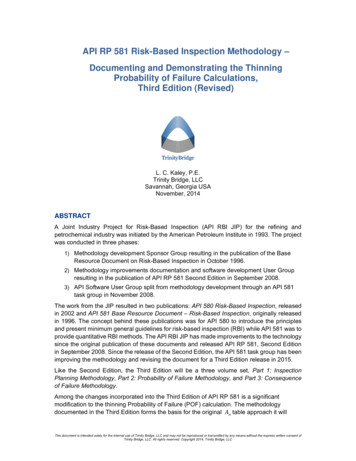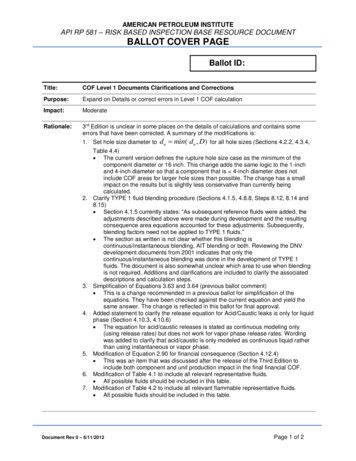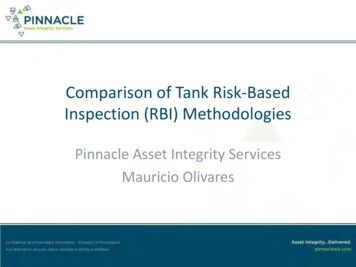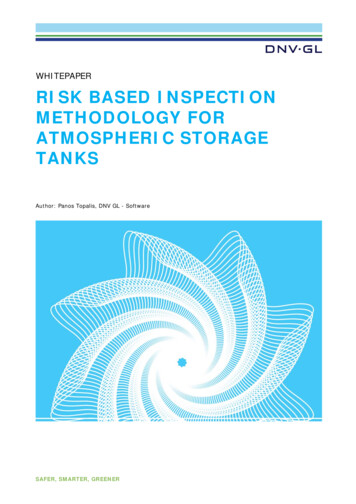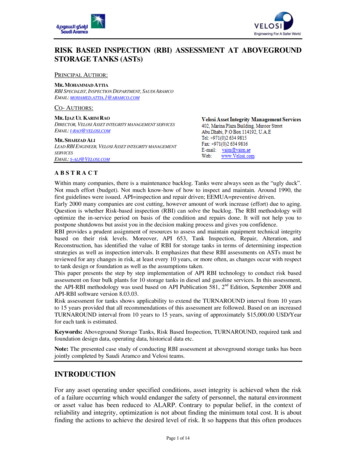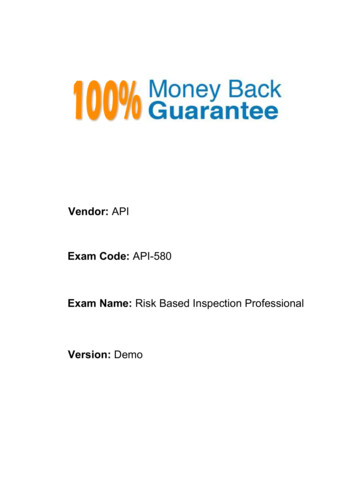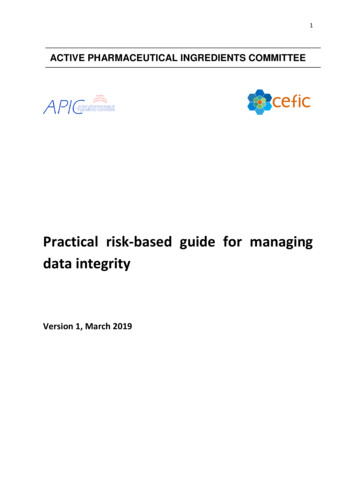
Transcription
1ACTIVE PHARMACEUTICAL INGREDIENTS COMMITTEEPractical risk-based guide for managingdata integrityVersion 1, March 2019
2PREAMBLEThis original version of this guidance document has been compiled by a subdivision of the APIC DataIntegrity Task Force on behalf of the Active Pharmaceutical Ingredient Committee (APIC) of CEFIC.The Task Force members are:Charles Gibbons, AbbVie, IrelandDanny De Scheemaecker, Janssen Pharmaceutica NVRob De Proost, Janssen Pharmaceutica NVDieter Vanderlinden, S.A. Ajinomoto Omnichem N.V.André van der Biezen, Aspen Oss B.V.Sebastian Fuchs, TereosDaniel Davies, Lonza AGFraser Strachan, DSMBjorn Van Krevelen, Janssen Pharmaceutica NVAlessandro Fava, F.I.S. (Fabbrica Italiana Sintetici) SpAAlexandra Silva, Hovione FarmaCiencia SANicola Martone, DSM Sinochem PharmaceuticalsUlrich-Andreas Opitz, Merck KGaADominique Rasewsky, Merck KGaAWith support and review from:Pieter van der Hoeven, APIC, BelgiumFrancois Vandeweyer, Janssen Pharmaceutica NVAnnick Bonneure, APIC, BelgiumThe APIC Quality Working Group
31 Contents1.General Section . 41.1Introduction . 41.2Objectives and Scope . 51.3Definitions and abbreviations . 51.4Overall Data Integrity Approach . 62Business Processing Mapping . 93Data and System Identification . 104Data and System Categorisation. 114.1Data Severity Assessment . 114.2System Profiling . 124.2.1System categorization . 124.2.2System categorization requirements . 144.3System Assessment . 175Risk Assessment . 336Risk Management. 367References . 388Examples . 398.1Production Systems and Process Risk Assessment . 398.2Laboratory Systems and Process Risk Assessment . 48
41. General Section1.1 IntroductionData integrity refers to the accuracy, completeness and consistency of GxP data over its entirelifecycle. The steps that need to be overseen include the initial generation and recording, theprocessing (incl. analysis, transformation or migration), the outcome/use, the retention, retrieval,archive and finally the destruction.Data integrity means that all the steps defined above are well managed, controlled and documentedand therefore the records of the activities follow the ALCOA principles described in the guidelines.The ALCOA and ALCOA principles have been in place for several years in the industry and are widelyknown and implemented. Achieving data integrity compliance, for paper, electronic and hybridsystems, requires translation of these principles into practical controls in order to assure GxPimpacting business decisions can be verified and inspected throughout the data lifecycle.Currently available regulatory guidelines have been used to elaborate the approach outlined in thispractical guide (see also section 7, References).The current guidelines on data integrity require that companies complete data integrity criticality andrisk assessments to ensure that the organizational and technical controls that are put in place arecommensurate with the level of risk to quality attributes.The guidelines emphasise the importance of creating and maintaining a working environment andorganisational culture that supports data integrity. Companies should establish data governanceprograms that address technical, procedural and behavioural aspects to assure confidence in dataquality and integrity.This document will not describe all the elements required for a data governance program in detail.However, some foundational principles are given below: Organisational CultureOrganisational culture has the potential to increase the possibility for lapses in data integrity;intentional (e.g. fraud or falsification) or unintentional (e.g. lack of understanding of responsibilitiesand/or requirements). To reduce this potential, organisations should aspire to an open culture wheresubordinates can challenge hierarchy, and full reporting of a systemic or individual failure is a businessexpectation. AwarenessIt is crucial that employees at all levels understand the importance of data integrity and the impactthat they can have on GxP data with the authorisations assigned for their job roles. Training is a majorcomponent of raising awareness and should be conducted periodically. The ALCOA concepts, and theacronym itself, are widely used by regulators and industry and should be incorporated into theprogram (e.g. within staff training, policies etc.). System and Process DesignCompliance with data integrity principles can be encouraged through the consideration of ease ofaccess, usability and location. For example:ooControl over blank paper templates for GxP data recordingControl of spreadsheets used for calculationsooAccess to appropriate clocks for recording timed eventsAccessibility of records at the locations where activities take place
5ooo User access rights and permissions that align with personnel responsibilitiesAutomation of GxP data capture where possibleAccess to electronic GxP data for staff performing data review activitiesManagement CommitmentSenior management should ensure that there is a written commitment to follow an effective qualitymanagement system and professional practices to deliver good data management. The commitmentsshould include An open quality cultureData integrity governanceAllocation of appropriate resourcesData integrity training for staffMonitoring of data integrity issues with CAPA taken to address issues identifiedMechanisms for staff to report concerns to management1.2 Objectives and ScopeThis document is based on general Data Integrity requirements and gathers practical experiences froma number of companies operating in the sector that can be used as guidance to others. It is not an allinclusive list of requirements but proposes a comprehensive approach that companies can adopt tohelp carry out their data integrity risk assessments.The guide is essentially practical and therefore, after the presentation of the approach and of thetools, the document includes some examples of executed assessments, categorisations and checklists that can be used by any company according to their individual needs. Each company can choosethe appropriate tools and categorisations that apply to their own business processes and systems.This guidance applies to all GxP processes and GxP data used in the manufacture and analysis of APIsfor use in human and veterinary drugs.1.3 Definitions and abbreviationsBusiness process: a set of structured activities or tasks that produce a specific service for a particular customeror customers. It is often visualised as a flowchart of a sequence of activities with decision points.Data: Facts, figures and statistics collected together for reference or analysis. All original records and true copiesof original records, including source GxP data and metadata and all subsequent transformations and reports ofthese GxP data, that are generated or recorded at the time of the GxP activity and allow full and completereconstruction and evaluation of the GxP activity.Raw data: Raw data is defined as the original record (data) which can be described as the first-capture of GxPinformation, whether recorded on paper or electronically. Information that is originally captured in a dynamicstate should remain available in that state.Metadata: Metadata are data that describe the attributes of other data and provide context and meaning.Typically, these are data that describe the structure, data elements, inter-relationships and othercharacteristics of data e.g. audit trails. Metadata also permit data to be attributable to an individual (or ifautomatically generated, to the original data source).
6Data severity assessment: within GxP data, different levels of severity can be defined as a function of its use.Typically, this is linked to the stage of manufacturing following the principle of increasing GxP outlined in ICHQ7. Alternatively, other factors such as impact on final product quality can be taken into account to furtherdifferentiate between severity categories.Data elements: (for the purpose of this document) individual GxP data items that are part of raw GxP data ormetadata, e.g. an operator name, a test date.Data Flow: diagram that maps the flow of information of any process or system (inputs, outputs, storage pointsand routes between each destination).Data process mapping: generation of a visual representation of the creation and movement of data through thebusiness process including documentation of the systems used.Data Audit Trail: appropriate audit trail elements supporting the acquisition, sequencing, processing, reportingand retention of GxP data for the release of product. Including all relevant or significant GxP data generated,which may affect the product (such as: analytical method validation, stability analysis, multiple sample/test runs,etc.), as determined by a risk assessment.LIMS: Laboratory Information Management SystemMES: Manufacturing Execution SystemPCS/DCS: process control systems (PCS) / distributed control systems (DCS)Process mapping: activities involved in defining what a business entity does, who is responsible, to whatstandard a business process should be completed, and how the success of a business process can be determined.System Audit Trail: a record of all administrator changes. The frequency of this review should be determinedbased on a risk assessment. This may be performed as part of the system periodic review as appropriate.True copy: A copy (irrespective of the type of media used) of the original record that has been verified (i.e. bya dated signature or by generation through a validated process) to have the same information, including datathat describe the context, content, and structure, as the original1.4 Overall Data Integrity ApproachWhen assessing data integrity risks within an organisation, companies may focus immediately onthose systems or areas that are the most obvious in this context, such as a particular software, aspecific lab system or instrument etc. Doing so creates the risk of forgetting less visible but stillimportant areas, processes or systems, or of failing to address integrity issues concerning data flowsbetween controlled environments.Therefore, this guide approaches data integrity in a holistic manner by looking at the organisationfrom a high-level business process perspective, subsequently diving deeper into underlying subprocesses and only at the end drilling down to individual activities or systems that involve GxP data.Figure 1 is a graphical representation of this approach and the sequence of steps that should helpassessors to obtain a complete and profound data integrity risk assessment.
7It should be noted that the proposed approach is suitable not only to assess risks related to systemsor processes already present in the organisation but also to proactively evaluate the requirements ofnew systems.Below is a short description of the sequence actions that are illustrated in the diagram. Details for themajor steps will be further elaborated in the following sections of this guideline (those sections arealso cross-referenced in Figure 1). Identify the company’s high-level GxP business processes (or having links to GxP activities)(ref. to section 2) Map each of the GxP business processes and their sub-processes down to level of processflows that consist of individual activities (refer to section 0) Identify the GxP data elements and the way the data flows (IN/OUT) between the differentprocess steps or activities (Data Process Mapping); (refer to section 0) Identify and isolate the individual systems (both paper and electronic) that manage (generate,store, transfer or process) GxP data (refer to section 0) Assign GxP data to a specific category based on a severity assessment (refer to section 4.1) Create a profile of each system based on the way GxP data is handled by that system (e.g.data generation, storage, processing, transfer or a combination thereof) and assign a categoryto the system based on its profile; (refer to section 4.2) Identify the gap between
Data integrity means that all the steps defined above are well managed, controlled and documented and therefore the records of the activities follow the ALCOA principles described in the guidelines. The ALCOA and ALCOA principles have been in place for several years in the industry and are widely known and implemented. Achieving data integrity compliance, for paper, electronic and hybridFile Size: 953KBPage Count: 54




